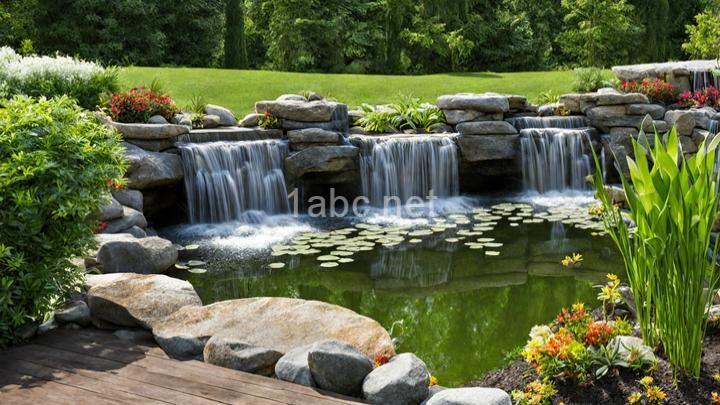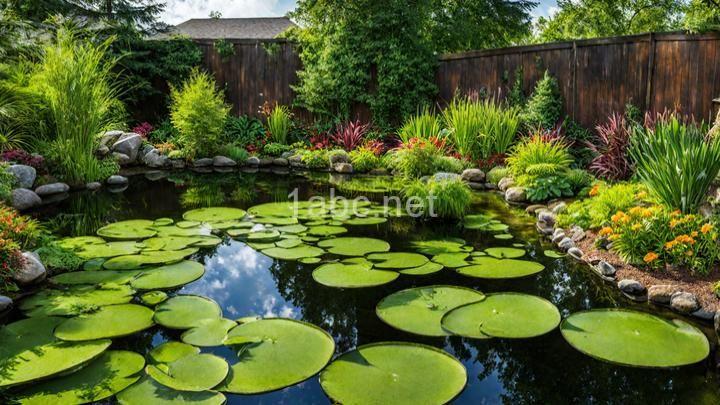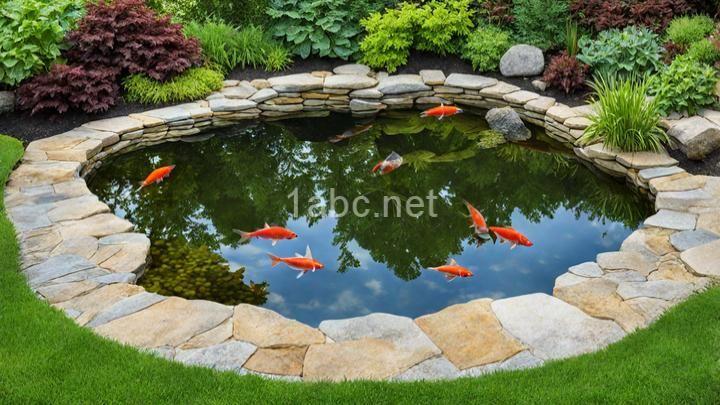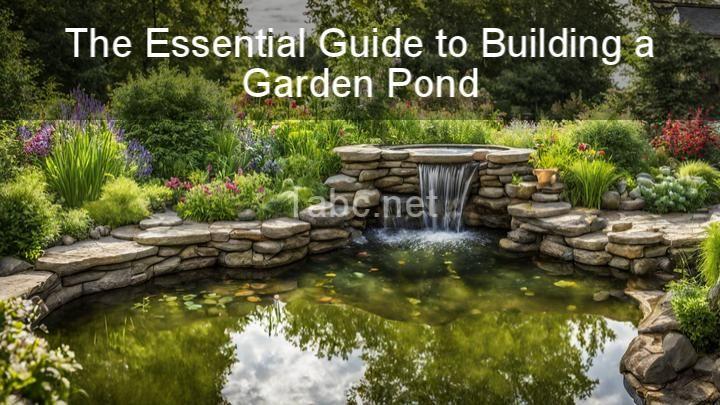Pond Design Inspiration: Enhance Your Landscape with Water Features

Introduction:
Welcome to our blog, where we will take you on a journey to explore the world of pond design. We want to share with you the beauty and tranquility that water features can bring to your outdoor space. Whether you have a small backyard or a sprawling garden, a pond can transform it into a serene oasis. So, grab a cup of coffee, sit back, and let's dive into the wonderful world of pond design.
I. Choosing the Right Location:
When it comes to building a pond, location is key. You want to find a spot that is not only visually appealing but also practical. Consider factors such as sunlight exposure, proximity to trees, and accessibility for maintenance. A sunny spot will help your aquatic plants thrive, but too much direct sunlight can cause algae bloom. Also, be mindful of any nearby trees that may shed leaves or branches into the pond, as this can create extra maintenance work for you. Lastly, think about how easy it will be for you to access the pond for regular cleaning and maintenance.
II. Determining the Size and Shape:
Now that you have chosen the perfect location for your pond, it's time to determine the size and shape. The size of your pond will depend on the available space in your yard and your personal preferences. If you have a small space, a compact pond can still create a stunning focal point. For larger areas, you have more flexibility to create a pond that suits your vision. As for the shape, there are endless possibilities. You can opt for a traditional rectangular shape, a kidney-shaped design, or even a more naturalistic shape that mimics the curves of a river or lake.
III. Selecting Pond Materials:
When it comes to pond construction, there are a few different materials to choose from. Preformed liners are a popular option as they are easy to install and come in a variety of shapes and sizes. Flexible liners offer more flexibility in terms of shape and size, but they require careful installation to prevent leaks. Concrete is another option for larger ponds, as it provides durability and stability. Consider the pros and cons of each material option before making your decision.
IV. Considering Water Features:
Water features are what truly bring a pond to life. From the soothing sound of a waterfall to the mesmerizing sight of a fountain, there are endless possibilities for creating unique visual effects. You can choose to incorporate one main water feature or combine multiple elements for a more dynamic design. Consider the size of your pond and the overall aesthetic you want to achieve when selecting water features. The key is to create a harmonious balance between the water and the surrounding landscape.
V. Adding Aquatic Plants:
Aquatic plants not only add beauty to your pond but also play a crucial role in maintaining a healthy ecosystem. They provide shade, oxygenate the water, and help control algae growth. Water lilies and lotus flowers are popular choices for larger ponds, as their vibrant blooms create a stunning display. For smaller ponds, marginal plants such as irises or rushes can add a touch of elegance. Consider the size of your pond and the specific requirements of each plant when selecting the right species for your design.
VI. Installing Filtration Systems:
Maintaining a clean and healthy pond requires a proper filtration system. Filtration systems remove debris, excess nutrients, and harmful bacteria from the water, ensuring a balanced ecosystem for your aquatic life. There are different types of filtration systems available, including mechanical filters, biological filters, and UV clarifiers. Each type has its own benefits, so it's important to understand how they work and choose the one that best suits your pond's needs.
VII. Incorporating Lighting:
Strategic lighting can truly elevate the beauty of your pond, both during the day and at night. Underwater lights can create a magical effect, illuminating the water and showcasing the plants and fish in your pond. Spotlights can be used to highlight specific features such as waterfalls or sculptures. Solar-powered lights are a great eco-friendly option, as they harness the energy of the sun to create stunning visual effects. Experiment with different lighting techniques to create the ambiance you desire.
VIII. Maintenance and Care:
To keep your pond in optimal condition, regular maintenance is essential. Monitor the water quality and make sure to test and balance the pH levels regularly. Remove any debris that falls into the pond, such as leaves or twigs, as they can contribute to poor water quality. Additionally, perform seasonal tasks such as trimming vegetation, cleaning filters, and protecting the pond from extreme weather conditions. There are tools and resources available to help you streamline these tasks and keep your pond in pristine condition.
Conclusion:
Congratulations! You have now gained a comprehensive understanding of pond design and are ready to embark on your own pond-building journey. Remember, a well-designed pond can transform your outdoor space into a tranquil oasis, providing you with a peaceful retreat right in your own backyard. So, let your creativity flow and explore the endless possibilities of pond design. Whether you choose a small, compact pond or a grand, elaborate design, the key is to create a space that brings you joy and serenity. Happy pond designing!
FREQUENTLY ASKED QUESTIONS
What are the benefits of adding a pond to my landscape?
Adding a pond to your landscape offers a multitude of benefits. Firstly, it enhances the overall aesthetic appeal of your outdoor space, creating a visually captivating focal point. The serene and tranquil atmosphere that a pond provides can help to reduce stress and promote relaxation. Additionally, the sound of running water can have a calming effect on the mind and create a soothing ambiance.From an ecological perspective, a pond attracts a diverse range of wildlife, including birds, frogs, and insects. This creates a mini-ecosystem in your backyard, fostering biodiversity and contributing to the overall health of the environment. It can also serve as a water source for various animals, particularly during dry periods.
A pond can also be utilized for educational purposes. It offers an opportunity to teach children about aquatic life and the importance of conservation. Furthermore, it can serve as a learning tool for gardening and water management techniques.
In terms of practicality, a pond can help to regulate the temperature in your garden by acting as a natural evaporative cooler during hot summer months. It also provides a source of water for irrigation, reducing the need to rely solely on municipal water supplies.
Lastly, a well-designed pond can increase the value of your property. It adds a unique and desirable feature that sets your landscape apart from others, making it more appealing to potential buyers.
Overall, adding a pond to your landscape not only enhances its beauty but also brings numerous benefits, both for your enjoyment and the environment.
How do I choose the right location for my pond?
Choosing the right location for your pond is crucial for its long-term success. Here are some factors to consider when deciding on the perfect spot:
-
Sunlight: Look for an area that gets at least six hours of direct sunlight every day. This is essential for the health and growth of aquatic plants and fish.
-
Shade: While sunlight is important, having some shade during the hottest part of the day can help prevent excessive algae growth. Consider nearby trees or structures that can provide shade.
-
Slope: Avoid areas with steep slopes as they can lead to erosion and water runoff. Look for a level area or a gentle slope that will allow water to flow naturally.
-
Accessibility: Choose a location that is easily accessible for maintenance, such as cleaning and adding water treatments. It should also be convenient for you to enjoy and observe your pond regularly.
-
Distance from trees: Avoid placing your pond directly under trees as falling leaves and debris can create extra maintenance work. Additionally, tree roots can potentially damage the pond liner.
-
Water source: Consider the proximity to a water source, such as a hose or rainwater collection system, for adding or replacing water when needed.
-
Wildlife and pets: Take into account any nearby wildlife or pets that may pose a risk to your pond inhabitants. For example, keep it away from areas frequented by predators or curious pets.
-
Aesthetics: Think about how the pond will fit into your overall landscape design. Consider the view from different angles and how it will complement your outdoor space.
Remember, planning and careful consideration of these factors will help you choose the right location for your pond, ensuring its longevity and enjoyment for years to come.
What other features can I add to my pond design?
There are several additional features you can consider adding to your pond design to enhance its aesthetics and functionality. Here are a few ideas:
-
Waterfall or Fountain: Installing a waterfall or fountain can add a beautiful focal point to your pond while also creating soothing sounds and improving water circulation.
-
Stream or Creek Bed: If you have enough space, you can create a natural-looking stream or creek bed that connects different areas of your pond. This can provide a more dynamic and visually appealing water feature.
-
Bog or Wetland Area: Adding a bog or wetland area to your pond can create a diverse habitat for aquatic plants and wildlife. It also helps to filter the water and improve its quality.
-
Bridge or Pathway: If your pond is large enough, consider incorporating a bridge or pathway that allows you to explore and enjoy different parts of your pond. This can also add an element of charm and accessibility.
-
Floating Plants: Floating plants like water lilies or lotus can add color and vibrancy to your pond. They also provide shade for fish and help to reduce algae growth by blocking sunlight.
-
Underwater Lighting: Installing underwater lights can illuminate your pond at night, creating a magical and enchanting atmosphere. It also allows you to enjoy your pond even after the sun goes down.
-
Fish or Wildlife Habitat: To encourage biodiversity and natural balance, you can create specific areas within your pond that provide shelter and breeding grounds for fish and other wildlife.
Remember to consider the size, depth, and overall design of your pond when incorporating additional features. It's important to ensure that they complement each other and create a cohesive and harmonious environment.
What is pond design inspiration?
Pond design inspiration refers to the ideas and influences that can help you create a visually appealing and functional pond in your outdoor space. It involves exploring various design concepts, styles, and elements that can be incorporated into your pond to make it unique and visually stunning.When seeking pond design inspiration, you can look at various sources such as nature itself, other existing ponds, online platforms, magazines, or even consult with professional pond designers. By exploring different design ideas and concepts, you can gather inspiration and find elements that resonate with your personal taste and the overall aesthetic of your outdoor space.
Some common pond design inspirations include incorporating waterfalls, rocks, plants, and aquatic life into the pond. You can also consider factors like the size and shape of the pond, the type of water feature you want to include, and the overall theme or style you want to achieve.
Remember, pond design inspiration is subjective and can vary based on individual preferences and the specific environment in which the pond will be located. It's important to consider factors such as maintenance requirements, budget, and the suitability of certain design elements for your particular space.
By exploring different pond design inspirations, you can gather ideas and create a pond that not only enhances the beauty of your outdoor area but also provides a tranquil and inviting space for you to enjoy.


